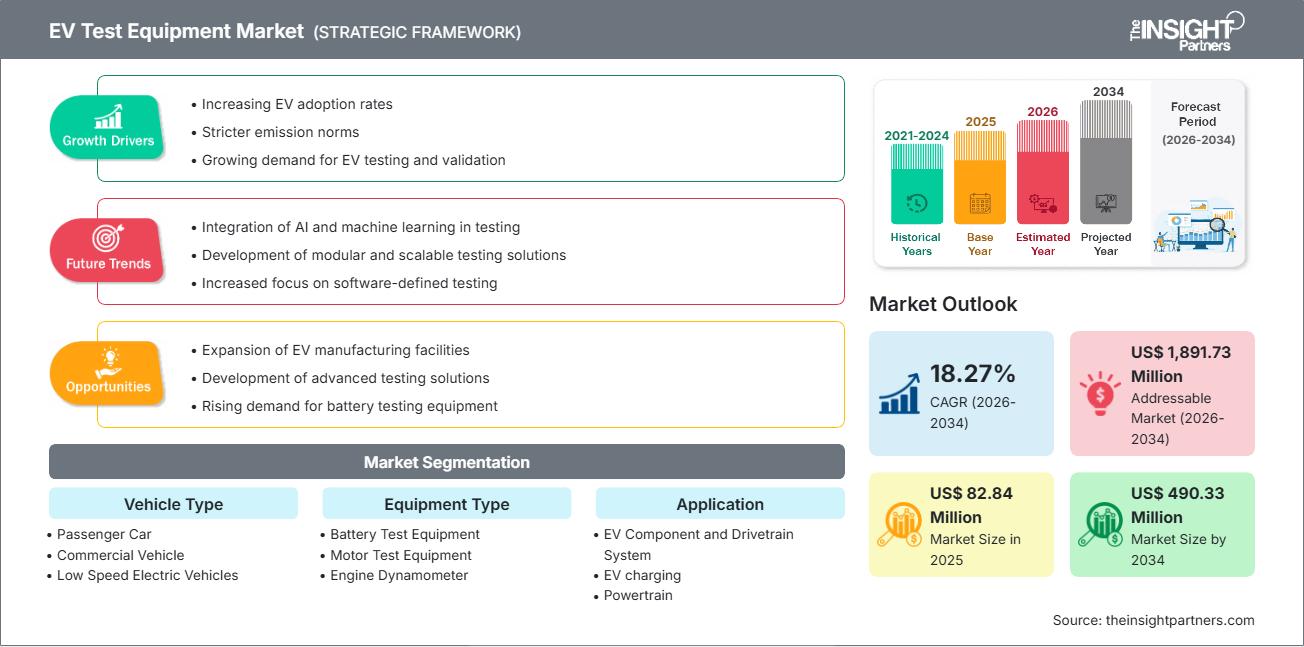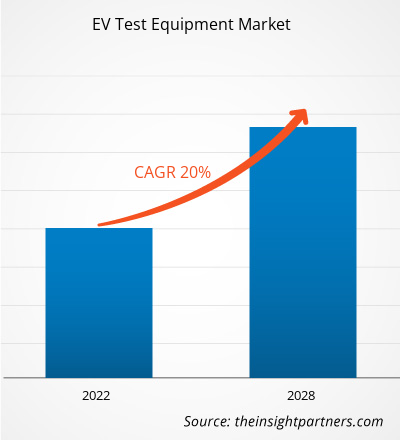Der Markt für Testgeräte für Elektrofahrzeuge wird bis 2034 voraussichtlich ein Volumen von 490,33 Millionen US-Dollar erreichen, gegenüber 82,84 Millionen US-Dollar im Jahr 2025. Es wird erwartet, dass der Markt im Zeitraum 2026–2034 eine durchschnittliche jährliche Wachstumsrate (CAGR) von 18,27 % verzeichnen wird.
Marktanalyse für EV-Testgeräte
Die Marktprognose für Testgeräte für Elektrofahrzeuge deutet auf ein starkes Wachstum hin, bedingt durch die steigenden Produktionsmengen von Elektrofahrzeugen, die rasanten Fortschritte bei Batterien und Leistungselektronik sowie die strengeren Validierungsanforderungen bei OEMs und Tier-1-Zulieferern. Das Marktwachstum wird durch den Bedarf an Kompatibilität mit sich schnell entwickelnden Ladestandards (AC/DC), Hochspannungsarchitekturen und die Integration von Echtzeit- und vernetzten Analysen begünstigt. Darüber hinaus trägt die Umstellung der Anbieter auf modulare, skalierbare Plattformen mit sicherheitskonformer Automatisierung zur Beschleunigung der Validierung und gleichzeitigen Senkung der Testkosten weiter zum Marktwachstum bei.
Marktübersicht für Testgeräte für Elektrofahrzeuge
Die Testausrüstung für Elektrofahrzeuge umfasst integrierte Hardware, Software und Automatisierungssysteme zur Validierung von Komponenten wie Batterien, Wechselrichtern, Motoren, Antriebssträngen und Ladegeräten sowie kompletten Antriebssystemen. Diese Lösungen decken spezialisierte Anwendungen ab, darunter Batteriezellen-Zyklentests, thermische Prüfungen, Dynamometertests von Motoren und Antriebssträngen sowie die Prüfung der Konformität von Ladeprotokollen. Der genaue Umfang dieses Produktsegments variiert je nach Branchenbericht erheblich. Führende Anbieter liefern vollintegrierte Systeme, die Fahrzeugsicherheit, Leistung, Effizienz und Interoperabilität gewährleisten. Zu den genannten Fähigkeiten des Sektors gehören dynamische Fahrzyklussimulationen, hochpräzise Datenerfassung und Konformitätsprüfungen sowohl für Batteriemanagementsysteme als auch für Ladeinfrastrukturen. Dies unterstreicht den Bedarf an präziser Validierung während des gesamten Forschungs- und Entwicklungsprozesses.
Passen Sie diesen Bericht Ihren Anforderungen an.
Sie erhalten eine kostenlose Anpassung aller Berichte – einschließlich Teilen dieses Berichts, Länderanalysen und Excel-Datenpaketen – sowie attraktive Angebote und Rabatte für Start-ups und Universitäten.
Markt für Testgeräte für Elektrofahrzeuge: Strategische Einblicke

-
Ermitteln Sie die wichtigsten Markttrends dieses Berichts.Diese KOSTENLOSE Probe beinhaltet eine Datenanalyse, die von Markttrends bis hin zu Schätzungen und Prognosen reicht.
Markttreiber und Chancen für Testgeräte für Elektrofahrzeuge
- Steigende Elektrofahrzeugproduktion und Plattform-Elektrifizierung: OEM-Roadmaps und Regierungsziele beschleunigen den Validierungsbedarf in den Bereichen Batterien, Leistungselektronik und Ladeinfrastruktur.
- Hochspannungsarchitekturen und Schnellladung: Der Übergang zu 800-V-Systemen und schneller Gleichstromladung erfordert neue Testprofile, höhere Leistungsbereiche und Protokollkonformität über CCS, CHAdeMO, GB/T und neue Standards hinweg, was zu Upgrades bei Labor- und End-of-Line-Geräten führt.
- Strenge Anforderungen an Sicherheit, Konformität und Zuverlässigkeit: Thermische Stabilität, Missbrauchstests und Lebensdauertests von Batterien sind entscheidend für die Reduzierung von Gewährleistungsrisiken. Auch der Markt für spezialisierte Batterietests wächst und spiegelt damit die gestiegenen Anforderungen an Sicherheit und Leistung wider.
Marktchancen:
- Fabrikautomatisierung und Ausweitung der End-of-Line-Prüfung: Skalierbare, flexible Testplattformen helfen OEMs, Taktzeiten zu reduzieren, die Ausbeute zu verbessern und die Einhaltung von Standards sicherzustellen.
- Integrierte Softwareanalysen und vernetzte Testökosysteme: Bedarf an Echtzeit-Dateneinblicken; die Vernetzung von Prüfständen, Laboren und Produktionslinien ermöglicht eine schnellere Ursachenanalyse und modellbasierte Validierung.
- Beschleunigung in Schwellenländern: Der asiatisch-pazifische Raum wird in mehreren Studien als die am schnellsten wachsende Region identifiziert, was auf Kapazitätserweiterungen der OEMs, die Lokalisierung der Lieferkette und politische Anreize zur Unterstützung von Ökosystemen für Elektrofahrzeuge zurückzuführen ist.
Marktsegmentierungsanalyse für EV-Testgeräte im Bericht
Der Marktanteil von Testgeräten für Elektrofahrzeuge wird segmentübergreifend analysiert, um ein besseres Verständnis seiner Struktur, seines Wachstumspotenzials und der aufkommenden Trends zu ermöglichen.
Nachfolgend ist der in den meisten Branchenberichten verwendete Standard-Segmentierungsansatz aufgeführt:
Nach Fahrzeugtyp
- Personenkraftwagen
- Nutzfahrzeug
- Langsam fahrende Elektrofahrzeuge
Nach Gerätetyp
- Batterietestgerät
- Motorprüfgeräte
- Motorenprüfstand
- Fahrgestell-Dynamometer
- Getriebedynamometer
- Kraftstoffeinspritzpumpenprüfer
- Wechselrichtertester
- EV-Antriebsstrangtest
- Bordladegerät
- AC/DC EVSE
Durch Antrag
- EV-Komponenten- und Antriebssystem
- Laden von Elektrofahrzeugen
- Antriebsstrang
Von Endnutzern
- OEMs
- Tier-1-Lieferanten
- Forschung und Lehre
Nach Geographie
- Nordamerika
- Europa
- Asien-Pazifik
- Süd- und Mittelamerika
- Naher Osten und Afrika
Regionale Einblicke in den Markt für EV-Testgeräte
Die regionalen Trends und Einflussfaktoren auf den Markt für Testgeräte für Elektrofahrzeuge im gesamten Prognosezeitraum wurden von den Analysten von The Insight Partners eingehend erläutert. Dieser Abschnitt behandelt außerdem die Marktsegmente und die geografische Verteilung des Marktes für Testgeräte für Elektrofahrzeuge in Nordamerika, Europa, Asien-Pazifik, dem Nahen Osten und Afrika sowie Süd- und Mittelamerika.
Umfang des Marktberichts über Testgeräte für Elektrofahrzeuge
| Berichtattribute | Details |
|---|---|
| Marktgröße im Jahr 2025 | 82,84 Millionen US-Dollar |
| Marktgröße bis 2034 | 490,33 Millionen US-Dollar |
| Globale durchschnittliche jährliche Wachstumsrate (2026 - 2034) | 18,27 % |
| Historische Daten | 2021-2024 |
| Prognosezeitraum | 2026–2034 |
| Abgedeckte Segmente |
Nach Fahrzeugtyp
|
| Abgedeckte Regionen und Länder |
Nordamerika
|
| Marktführer und wichtige Unternehmensprofile |
|
Marktdichte der Akteure im Bereich der Testgeräte für Elektrofahrzeuge: Auswirkungen auf die Geschäftsdynamik verstehen
Der Markt für Testgeräte für Elektrofahrzeuge wächst rasant, angetrieben durch die steigende Nachfrage der Endverbraucher. Gründe hierfür sind unter anderem sich wandelnde Verbraucherpräferenzen, technologische Fortschritte und ein wachsendes Bewusstsein für die Vorteile der Produkte. Mit steigender Nachfrage erweitern Unternehmen ihr Angebot, entwickeln innovative Lösungen für die Bedürfnisse der Verbraucher und nutzen neue Trends, was das Marktwachstum zusätzlich beflügelt.

- Verschaffen Sie sich einen Überblick über die wichtigsten Akteure im Markt für EV-Testgeräte.
Marktanteilsanalyse für EV-Testgeräte nach Regionen
Der asiatisch-pazifische Raum dürfte dank lokaler Lieferketten für Elektrofahrzeuge, Kapazitätserweiterungen der Erstausrüster und staatlicher Förderprogramme das schnellste Wachstum verzeichnen. Mordor Intelligence identifiziert den asiatisch-pazifischen Raum ausdrücklich als den am schnellsten wachsenden Markt bis 2030 und beobachtet dabei starke Investitionen in die Validierung von Batterien und Leistungselektronik.
Der Markt für Testgeräte für Elektrofahrzeuge weist aufgrund von Faktoren wie Produktionskapazitäten für Elektrofahrzeuge, Ausbau der Ladeinfrastruktur, Normenentwicklung und regulatorischer Unterstützung in den einzelnen Regionen unterschiedliche Wachstumsverläufe auf. Nachfolgend finden Sie eine Zusammenfassung der Marktanteile und Trends nach Regionen:
-
Nordamerika
- Marktanteil: Bedeutender Marktanteil, der auf die starke Präsenz von OEMs/Tier-1-Zulieferern, frühe Standardisierungsbemühungen im Bereich der Ladeinfrastruktur und vernetzte Testimplementierungen zurückzuführen ist.
-
Wichtigste Einflussfaktoren:
- Automatisierung am Ende der Produktionslinie und Standardisierungsbereitschaft für EVSE und E-Antriebsstränge.
- Validierungstiefe der Batterie und Einhaltung der Sicherheits-/Qualitätsstandards in Forschung und Entwicklung sowie in der Fertigung.
- Trends: Stärkere Integration von Testdaten in Manufacturing Execution Systems und digitale Zwillinge, um Hochlaufprozesse zu beschleunigen und die Kosten pro Test zu senken.
2. Europa
- Marktanteil: Stark aufgrund fortschrittlicher Elektromobilitätspolitik, internationaler Präsenz der Originalausrüster und umfassender Standardisierung beim AC/DC-Laden.
-
Wichtigste Einflussfaktoren:
- Interoperabilität und Protokollkonformität über verschiedene Ladenetzwerke hinweg.
- Effizienz und thermische Validierung der Leistungselektronik für autobahntaugliche batterieelektrische Fahrzeuge.
- Trends: Schwerpunkt auf modularen Dynamometer- und Wechselrichterprüfständen, die auf 800-V+-Plattformen und Effizienzvorschriften abgestimmt sind.
3. Asien-Pazifik
- Marktanteil: Am schnellsten wachsende Region dank Massenproduktion und Investitionen in das Batterie-Ökosystem.
-
Wichtigste Einflussfaktoren:
- Ausbau der OEM-Kapazitäten und Lokalisierung der Lieferketten.
- Politische Anreize für die Einführung von Elektrofahrzeugen und den Ausbau der Infrastruktur.
- Trends: Verstärkter Einsatz integrierter Testlabore, die von der Zelle bis zum System reichen, und schnelle EVSE-Einführung mit Protokoll-, Sicherheits- und Leistungsvalidierung im großen Maßstab.
4. Süd- und Mittelamerika
- Marktanteil: Im Aufwind; die Akzeptanz hängt mit der Elektrifizierung städtischer Fahrzeugflotten und dem Ausbau von Ladeinfrastruktur zusammen.
-
Wichtigste Einflussfaktoren:
- Öffentlich-private Partnerschaften für die Ladeinfrastruktur für Elektrofahrzeuge.
- OEM-Pilotprogramme und regionale Montage.
- Trends: Präferenz für cloudbasiertes Testmanagement und kostengünstige modulare Systeme zur Unterstützung kleinerer Labore und Pilotlinien.
5. Naher Osten und Afrika
- Marktanteil: Im Entwicklungsstadium; verankert durch nationale Strategien in ausgewählten Volkswirtschaften und Demonstrationsflotten.
-
Wichtigste Einflussfaktoren:
- Infrastrukturausbau und Angleichung der Standards für Interoperabilität.
- Sonderwirtschaftszonen mit Schwerpunkt auf Komponentenfertigung und Prüfdienstleistungen.
- Trends: Die schrittweise Integration von Konformitätsprüfungen für Ladeinfrastruktur in umfassendere Smart-City-Initiativen und von Energieversorgern unterstützte Ladeprogramme.
Marktdichte der Akteure auf dem Markt für Testgeräte für Elektrofahrzeuge: Auswirkungen auf die Geschäftsdynamik verstehen
Hohe Marktdichte und starker Wettbewerb
Der Wettbewerb zwischen globalen Marktführern im Prüfgerätebereich und spezialisierten Nischenanbietern verschärft sich. AVL, TÜV Rheinland und HORIBA zählen zu den führenden Anbietern von Prüfgeräten für Elektrofahrzeuge und bieten ein breit gefächertes Portfolio an Prüfständen, Batterie-/Leistungselektronik sowie Konformitätsdienstleistungen.
Dieses wettbewerbsintensive Umfeld zwingt die Anbieter dazu, sich durch Folgendes zu differenzieren:
- Durchgängige Integration von Batterie-, Wechselrichter-, Motor-, Antriebsstrang- und EVSE-Tests, einschließlich Protokoll- und Sicherheitskonformität.
- Skalierbare, modulare Plattformen, die sich an Forschungs- und Entwicklungs-, Pilot- und Serienproduktionsumgebungen anpassen lassen; ein Schwerpunkt liegt auf der Erweiterung der End-of-Line-Tests für die Herstellung von Elektrofahrzeugen und Ladeinfrastruktur.
- Interoperabilität und Standardabdeckung über CAN/LIN/Ethernet, Hochspannungsbereiche und Multi-Protokoll-Laden hinweg.
Chancen und strategische Schritte
- Partnerschaften mit OEMs und Betreibern öffentlicher Ladestationen eingehen, um gemeinsam Testprotokolle zu entwickeln und die Interoperabilität für AC/DC-Ladeinfrastruktur zu beschleunigen.
- Investieren Sie in KI/ML-gestützte Analytik zur Anomalieerkennung, Ertragssteigerung und beschleunigten Ursachenanalyse bei Batterie- und Leistungselektroniktests.
- Erweitern Sie die End-of-Line-Testsuiten, die die Brücke zwischen Designvalidierung und Fertigungsbereitschaft schlagen und so Nacharbeiten und Feldausfälle reduzieren.
Die wichtigsten Unternehmen, die auf dem Markt für Testgeräte für Elektrofahrzeuge tätig sind, sind:
- National Instruments Corporation – Vereinigte Staaten
- Horiba Ltd. – Japan
- Arbin Instruments – Vereinigte Staaten
- Maccor Inc. – Vereinigte Staaten
- KEYSIGHT TECHNOLOGIES, INC. – Vereinigte Staaten
- Froude, Inc. – Vereinigte Staaten
- Dynomerk Controls India
- Comemso electronics GmbH, Deutschland
- Dürr Gruppe Deutschland
Hinweis: Die oben aufgeführten Unternehmen sind nicht in einer bestimmten Reihenfolge geordnet.
Neuigkeiten und aktuelle Entwicklungen auf dem Markt für Testgeräte für Elektrofahrzeuge
- National Instruments Corporation (NI) hat Weiterentwicklungen bei Testlösungen für Elektrofahrzeugbatterien angekündigt. NI präsentiert verbesserte modulare Batterietester und unternehmensweite Labormanagementsysteme, die Validierungsprozesse für Elektrofahrzeugbatterien optimieren. Die neuen Lösungen integrieren Echtzeit-Datenanalyse und CAN/Ethernet-Kommunikation und ermöglichen es OEMs und Tier-1-Zulieferern, die Prüfung von Batteriepacks und -modulen zu beschleunigen und gleichzeitig die Einhaltung der sich stetig weiterentwickelnden Sicherheitsstandards zu gewährleisten.
- Horiba Ltd. hat sein Portfolio für die Prüfung von Elektrofahrzeugen und Brennstoffzellen erweitert. Das Unternehmen präsentierte neue, schlüsselfertige Validierungssysteme für Batterien und Brennstoffzellen, die speziell für die Entwicklung von batterieelektrischen (BEV) und brennstoffzellenbetriebenen (FCEV) Fahrzeugen entwickelt wurden. Aufbauend auf den Übernahmen von MIRA und FuelCon bietet Horiba nun integrierte Lösungen für die Prüfung von Batteriepacks hinsichtlich Haltbarkeit, Effizienz und Zertifizierung. Diese Entwicklungen stärken die Position des Unternehmens als weltweit führender Anbieter von Prüfungen für Antriebsstränge und Energiesysteme von Elektrofahrzeugen.
- Arbin Instruments hat dynamische Fahrzyklussimulationen für Elektrofahrzeugbatterien eingeführt. Das Unternehmen kündigte Upgrades seiner Batterietestplattformen an, darunter fortschrittliche, temperaturstabile Kammern und die CAN-Bus-Integration mit dem Batteriemanagementsystem (BMS). Die neuen Systeme ermöglichen die präzise Nachbildung realer Fahrbedingungen und unterstützen OEMs und Forschungseinrichtungen bei der Validierung von Batterietechnologien der nächsten Generation für Elektrofahrzeuge.
Marktbericht über Testgeräte für Elektrofahrzeuge – Abdeckung und Ergebnisse
Der Bericht „Marktgröße und Prognose für Testgeräte für Elektrofahrzeuge (2021–2034)“ bietet eine detaillierte Analyse des Marktes und deckt folgende Bereiche ab:
- Marktgröße und Prognose für EV-Testgeräte auf globaler, regionaler und Länderebene für alle wichtigen Marktsegmente, die im Geltungsbereich abgedeckt werden
- Trends im Markt für Testgeräte für Elektrofahrzeuge sowie Marktdynamiken wie Treiber, Hemmnisse und wichtige Chancen
- Detaillierte PEST- und SWOT-Analyse
- Marktanalyse für Prüfgeräte für Elektrofahrzeuge: Wichtige Markttrends, globale und regionale Rahmenbedingungen, Hauptakteure, regulatorische Rahmenbedingungen und aktuelle Marktentwicklungen
- Branchenlandschafts- und Wettbewerbsanalyse mit Fokus auf Marktkonzentration, Heatmap-Analyse, führende Akteure und aktuelle Entwicklungen im Markt für Testgeräte für Elektrofahrzeuge
- Detaillierte Unternehmensprofile
- Historische Analyse (2 Jahre), Basisjahr, Prognose (7 Jahre) mit CAGR
- PEST- und SWOT-Analyse
- Marktgröße Wert/Volumen – Global, Regional, Land
- Branchen- und Wettbewerbslandschaft
- Excel-Datensatz
Aktuelle Berichte
Erfahrungsberichte
Grund zum Kauf
- Fundierte Entscheidungsfindung
- Marktdynamik verstehen
- Wettbewerbsanalyse
- Kundeneinblicke
- Marktprognosen
- Risikominimierung
- Strategische Planung
- Investitionsbegründung
- Identifizierung neuer Märkte
- Verbesserung von Marketingstrategien
- Steigerung der Betriebseffizienz
- Anpassung an regulatorische Trends






















 Kostenlose Probe anfordern für - Markt für Testgeräte für Elektrofahrzeuge
Kostenlose Probe anfordern für - Markt für Testgeräte für Elektrofahrzeuge